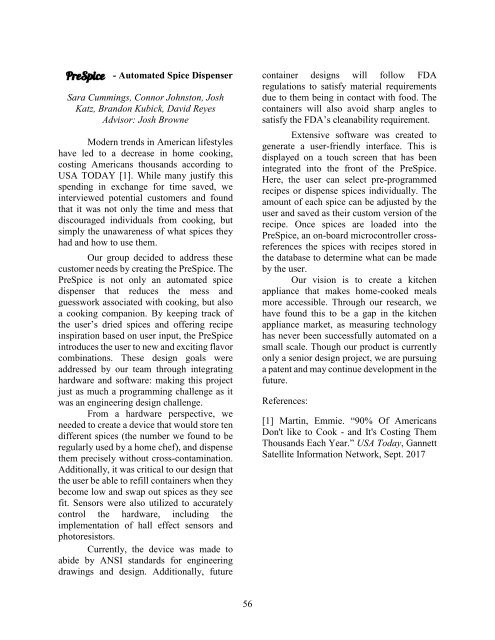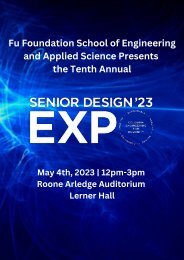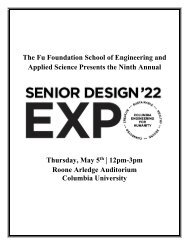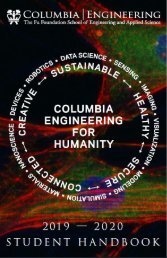Senior Design Expo 2019
The Senior Design Expo, held annually in May at Columbia University, is an opportunity for Columbia Engineering students to showcase what they have learned in their foundational math and science courses together with their engineering courses in innovative, creative, and purposeful designs and prototypes. Each year the Expo showcases more than 60 projects across all nine departments. Projects have included cutting-edge robotics, the New York City subway system, language technology, proposals for bridges to span the Hudson river, and much more.
The Senior Design Expo, held annually in May at Columbia University, is an opportunity for Columbia Engineering students to showcase what they have learned in their foundational math and science courses together with their engineering courses in innovative, creative, and purposeful designs and prototypes. Each year the Expo showcases more than 60 projects across all nine departments. Projects have included cutting-edge robotics, the New York City subway system, language technology, proposals for bridges to span the Hudson river, and much more.
You also want an ePaper? Increase the reach of your titles
YUMPU automatically turns print PDFs into web optimized ePapers that Google loves.
- Automated Spice Dispenser<br />
Sara Cummings, Connor Johnston, Josh<br />
Katz, Brandon Kubick, David Reyes<br />
Advisor: Josh Browne<br />
Modern trends in American lifestyles<br />
have led to a decrease in home cooking,<br />
costing Americans thousands according to<br />
USA TODAY [1]. While many justify this<br />
spending in exchange for time saved, we<br />
interviewed potential customers and found<br />
that it was not only the time and mess that<br />
discouraged individuals from cooking, but<br />
simply the unawareness of what spices they<br />
had and how to use them.<br />
Our group decided to address these<br />
customer needs by creating the PreSpice. The<br />
PreSpice is not only an automated spice<br />
dispenser that reduces the mess and<br />
guesswork associated with cooking, but also<br />
a cooking companion. By keeping track of<br />
the user’s dried spices and offering recipe<br />
inspiration based on user input, the PreSpice<br />
introduces the user to new and exciting flavor<br />
combinations. These design goals were<br />
addressed by our team through integrating<br />
hardware and software: making this project<br />
just as much a programming challenge as it<br />
was an engineering design challenge.<br />
From a hardware perspective, we<br />
needed to create a device that would store ten<br />
different spices (the number we found to be<br />
regularly used by a home chef), and dispense<br />
them precisely without cross-contamination.<br />
Additionally, it was critical to our design that<br />
the user be able to refill containers when they<br />
become low and swap out spices as they see<br />
fit. Sensors were also utilized to accurately<br />
control the hardware, including the<br />
implementation of hall effect sensors and<br />
photoresistors.<br />
Currently, the device was made to<br />
abide by ANSI standards for engineering<br />
drawings and design. Additionally, future<br />
container designs will follow FDA<br />
regulations to satisfy material requirements<br />
due to them being in contact with food. The<br />
containers will also avoid sharp angles to<br />
satisfy the FDA’s cleanability requirement.<br />
Extensive software was created to<br />
generate a user-friendly interface. This is<br />
displayed on a touch screen that has been<br />
integrated into the front of the PreSpice.<br />
Here, the user can select pre-programmed<br />
recipes or dispense spices individually. The<br />
amount of each spice can be adjusted by the<br />
user and saved as their custom version of the<br />
recipe. Once spices are loaded into the<br />
PreSpice, an on-board microcontroller crossreferences<br />
the spices with recipes stored in<br />
the database to determine what can be made<br />
by the user.<br />
Our vision is to create a kitchen<br />
appliance that makes home-cooked meals<br />
more accessible. Through our research, we<br />
have found this to be a gap in the kitchen<br />
appliance market, as measuring technology<br />
has never been successfully automated on a<br />
small scale. Though our product is currently<br />
only a senior design project, we are pursuing<br />
a patent and may continue development in the<br />
future.<br />
References:<br />
[1] Martin, Emmie. “90% Of Americans<br />
Don't like to Cook - and It's Costing Them<br />
Thousands Each Year.” USA Today, Gannett<br />
Satellite Information Network, Sept. 2017<br />
56








